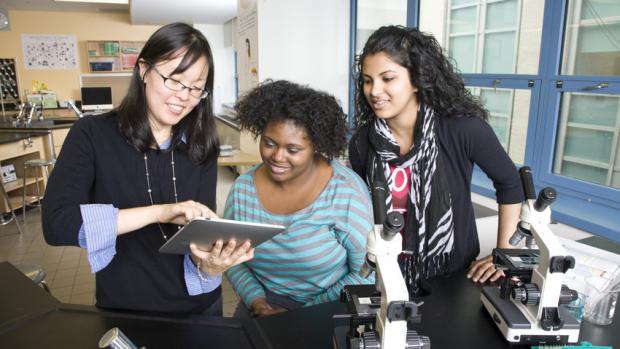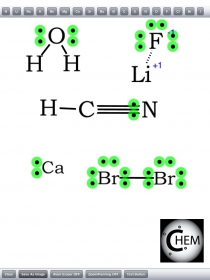New iPad App Makes Chemistry Just Plain Fun for Teens

Get the app from iTunes App Store
Teens love gadgets, especially tablets, mobile consoles and smart phones with touch screens that allow for both visual and tactile experiences. Applying that insight to pedagogy, Polytechnic Institute of New York University (NYU-Poly) Assistant Professor of Chemical and Biological Sciences Jin Kim Montclare and NYU-Poly students have created a digital app for the iPad that brings chemistry to life by making it intuitive, interactive, engaging and just plain fun.
Montclare’s team developed the app, called Lewis Dots, as part of a program that put dozens of iPads in the hands of 10th grade girls at Brooklyn's Urban Assembly Institute of Math and Science for Young Women (UAI), where Montclare is a mentor. “When the iPad launched, I realized it could be a valuable tool to engage students in chemistry at a young age – the shortage of students entering college to study science and engineering is particularly acute among girls in underserved minority groups,” Montclare says.

The new iPad app on iTunes allows students to manipulate Lewis Dot structures of chemical compounds like the ones shown, of water, lithium fluoride, bromine, hydrogen cyanide and calcium ion. The green dots represent the lone pairs and lines represent bonds between atoms.
The app is based on the eponymous molecular diagrams familiar to chemistry students in which elements are depicted as letter abbreviations, and electrons and bonds are dots and dashes. Available as a free iPad download from iTunes, Lewis Dots takes the pencil-and-paper template a step further: Students can drag periodic elements and electrons about the iPad touch screen to make and break bonds and assemble molecules. They learn about ionic and covalent bonding in the process, since heuristics determine which atoms can form which kinds of bonds. Users can also save the structures and diagrams as images in Photos App with the tap of a button.
Lewis Dots was developed by Carlo Yuvienco, a NYU-Poly biomedical engineering doctoral candidate and a National Science Foundation (NSF) GK-12 fellow in the Applying Mechatronics to Promote Science project. Instead of hiring a software consultant (which would have cost a fortune), Yuvienco found a few nooks and crannies in his packed schedule, plunked down $99 to become a Mac IO developer, and wrote the app based on the UAI chemistry curriculum.
"At the time I was juggling a fellowship and research, but I knew Dr. Montclare was in a bind,” he says. “But I also knew it was a worthwhile idea, and I felt I had a little co-ownership with it." Two NYU-Poly undergraduates, Maurica Lewis and Jinhui Zhao, helped develop the teaching interface and actually implemented the use of the Lewis Dots app in the tenth grade classroom.
One benefit of the Lewis Dots app is that it doesn't limit the size of the molecule a user can create the way, say, a piece of paper does. "You can build molecules as big as you want. And sometimes you want to erase or delete, and this lets you do that easily as well," Yuvienco says. "The beauty of the app is that one can learn from scratch by using it. It’s simple functionality but that's what chemistry is: connecting the dots between atoms.”
Montclare says that for the high school students the app goes beyond what a computer can do. "Yes, you can do visualization of molecules on computers – and we have done that using 3D molecular visualization programs – but I wanted to give students an interface that lets them understand it by actually touching the screen. And it helps students get excited about science, engineering because the interface itself is technology.”
Word is getting out about Lewis Dots as Montclare submitted a paper on the app to the Journal of Chemical Education. As part of its peer review process, chemistry teachers around the country will be looking at Lewis Dots. "It will be good in terms of getting exposure and feedback on whether teachers and students like it," says Montclare.
Next up is a range of new functions such as letting teachers project diagrams from the app on a classroom screen. The NYU-Poly team also plans to add electrochemistry heuristics. "And we are thinking about balancing equations, which is hard for some students,” says Montclare.
Yuvienco says the key is not to just blindly add functionality, just for the sake of having lots of features. “We want them to be geared toward a curriculum – toward the student – with a pedagogical objective."
But even as a 1.0 model, Lewis Dots has been a big hit with UAI tenth graders. "They think chemistry is fun, and are now a more positive about science," says Montclare.
The project development and iPads for the UAI students were provided through grants from The Camile & Henry Dreyfus Foundation, The Teagle Foundation and the NSF Materials Research Science & Engineering Centers (MRSEC) program.




